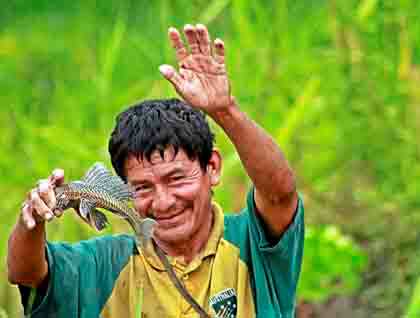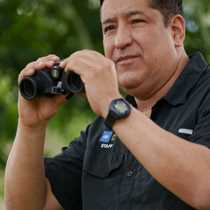One of my favorite days of this expedition started with a skiff ride exploration of an oxbow lake known as Atun Poza. It was a successful morning for we spotted several bird species and several three-toed sloths. We even had the chance to come closer to a local fisherman who gently showed us the first catch of the day. The icing on the cake was, for many of our guests, the experience of having our breakfast outdoors onboard the skiffs! We had our first meal of the day served in the most fashionable way including white gloves on our bartender and naturalists’ hands and fabric napkins in our laps. As a background we had the green surroundings and a concert of tropical sounds as companions all while being covered with the rain forest. On our way back we paid a short visit to the small village that holds the same name as the lake, Atun Poza Village. As most of the area is underwater at this time of the year, the villagers adapted a boardwalk to go directly from the skiffs inside a small house on stilts where we observed their handcrafts.
At around lunchtime we arrived to the farthest destination of our expedition this week, the Pacaya River. Early in the afternoon at 1500 we started to travel with our skiffs up the Pacaya River. Our goal was to go as far as we could in this remote river. The fun was not over yet for as soon as the skiffs arrived to a large black water oxbow lake called Yanayacu Lake (black water lake) we went swimming in this remote location! Many adventurous swimmers went in the water for refreshing swim! There were some pink river dolphins in the surroundings that were seen or heard while swimming.
After swimming we continue exploring the area. It was a successful afternoon in terms of wildlife sightings. We spotted a couple of red howler monkey troops. This monkey species is one of largest monkey species in South America and one of the most famous and attractive for they have one of the most impressive voices in the neotropical rain forest. In addition to the many mammal species we saw several bird species as well. Two species are well worthy to mention. We spotted a flock of hoatzins as well. This prehistoric-looking bird has a peculiar natural history that has made it famous. It feeds exclusively on leaves and their young have claws in the wings to climb out of the water after escaping from predators. A couple of gorgeous blue and yellow macaws flocks were admired as well.
On the way back accompanied by a pertinent tropical rain we could not avoid thinking on how wonderful our day has been in the magical Peruvian Upper Amazon.







